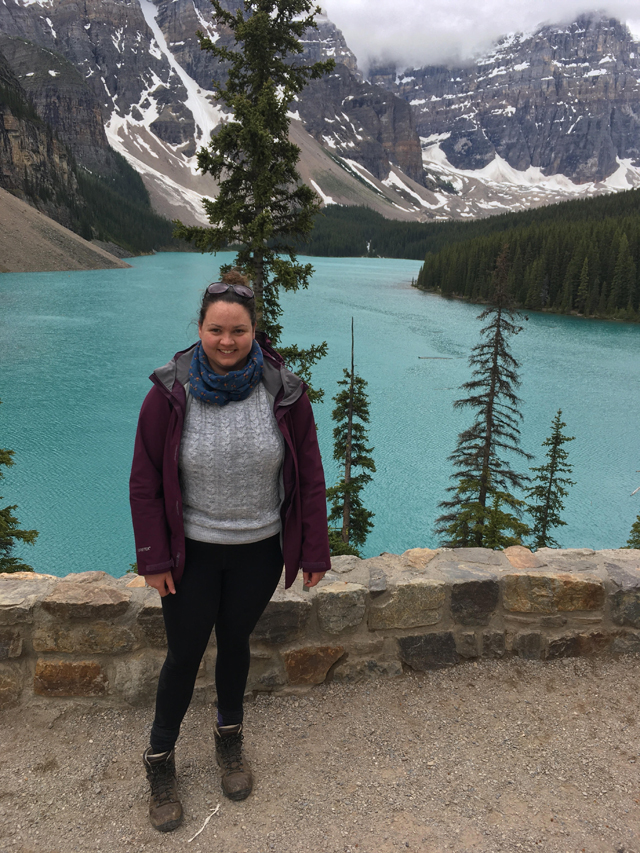6 January 2023–Rebecca Salvage’s high school in the U.K. didn’t offer Earth sciences as a course, but she loved physical geography and chemistry. One of her teachers suggested that Salvage consider a geology degree at university.
“When I got there, I knew this was what I wanted to do,” recalls Salvage, now a research associate at the University of Calgary. “I love the range of disciplines in Earth sciences: maths, geography, chemistry, physics, art and visualization—it’s got it all!”
She studied abroad at the University of Oregon in her third year at the University of Bristol, and a vacation visit to Mount St. Helens cemented her desire to work in geophysics, studying volcanoes and earthquakes. Salvage began with volcanoes, completing a Ph.D. at the University of Leeds that looked at using seismic signals to forecast volcanic processes such as dome collapse events at Soufrière Hills in Montserrat and eruptions at Chiles-Cerro Negro on the border between Ecuador and Colombia.
“My first postdoc was at the Observatorio Vulcanológico y Sismológico de Costa Rica where I was part of a team that undertook real-time monitoring of seismicity associated with the active volcanoes in the country, as well as regional seismicity,” Salvage said. “I spent time in the field, as well as developing codes to classify incoming seismicity and use it as a forecasting tool.”
Today, Salvage is applying many of the same skills and analyses to human-induced seismicity related to the energy sector in Canada. “I still look at the continuous seismic signals and write code to undertake event detection and location analysis, calculate magnitudes and source characteristics and use ambient noise to determine changes in the subsurface – it’s just now I focus on human-induced seismicity as opposed to that associated with volcanoes,” she said.

The development of fractures—and the associated seismicity—is important in both environments, she noted.
“In reservoir environments fractures are necessary for commercial success of the projects, and so being able to map them may help on future projects in the area as well as tell us something about the stress field,” Salvage said. “In volcanic environments, the development of fractures could indicate pathways to the surface through which fluid or gas, water or magma may migrate, which is important for hazard and risk mitigation.”
The detection and analysis of microseismicity is another aspect that connects research in both environments. “Microseismicity is kind of a broad term which is often misused,” Salvage explained. “Microseismicity refers to small seismic events, in terms of magnitudes, which can be either natural or human-induced.”
One of the best-known microseisms is the background “hum” – caused by waves in the oceans and small lakes – that the Earth gives off, she said, although now the term is often associated with human-induced seismicity.
“The reason for this is that typically these operations produce much lower magnitude seismic events than natural seismicity. The largest human-induced events are closer to a magnitude 5, compared to natural events which we know can exceed magnitude 9.5,” she said.
Being able to detect and analyze small magnitude events has helped seismologists “better understand evolving sequences of seismicity,” Salvage said. “There are examples where we previously thought there were periods of quiescence—no earthquakes—but this may not actually be the case. It’s just that the events were too small for us to detect at the time.”
The increasing popularity of machine learning and fiber optic technology allow seismologists to better collect and analyze massive amounts of data quickly, she noted. In particular, fiber optic or distributed acoustic sensing (DAS)’s excellent spatial resolution over a range of frequencies “means that a single instrument can detect teleseismic, microseismic and even slow slip or aseismic events. My work has started to move toward looking for slow slip processes using DAS data,” she said.
Salvage said she is “pretty open” as to where she wants her career to go next, whether it be academia or industry. “For me, it’s about having the right supervisors and colleagues, and having interesting data to work with,” she said. “I have always tried to take opportunities primarily based on my interest in the subject matter, and this is how I plan to continue with my career.”
Volcanoes remain a source of fascination for her, and “I’d also love to get more involved in using seismology and fiber optic monitoring for renewable energy projects such as [carbon capture, utilization and storage] CCUS and geothermal,” she added. “As these technologies develop and more demand is placed on them as we try to reach net zero [emissions], I think geoscientists and seismologists will be really important to enhance our understanding of ongoing processes in the subsurface, and for risk assessment issues.”
SSA At Work is a monthly column that follows the careers of SSA members. For the full list of issues, head to our At Work page.
